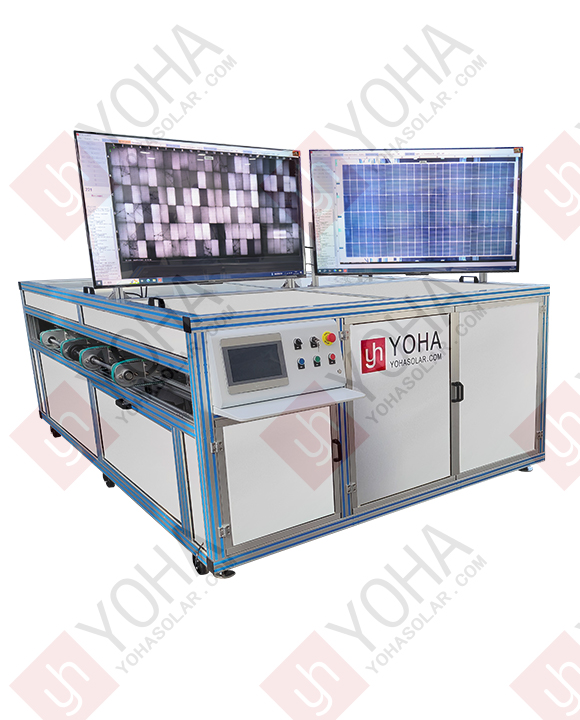Welcome to Wuhan Yoha Solar Technology Co., Ltd!
common problem
Site Map
Language:
 Chinese
Chinese
 English
English
Welcome to Wuhan Yoha Solar Technology Co., Ltd!
common problem
Site Map
Language:
 Chinese
Chinese
 English
English
With the rapid development of the photovoltaic industry today, the quality inspection of solar modules has become a critical link in ensuring the efficient operation and long-term reliability of systems. Among these, the Electroluminescence (EL) tester, as a non-destructive testing equipment, is widely used for detecting internal defects in solar modules, such as micro-cracks, fragments, and process issues. For photovoltaic equipment manufacturers and users, selecting a suitable EL tester is crucial. So, what are the key indicators that need to be focused on for solar module EL testers? This article will delve into this issue, helping industry professionals fully understand the performance elements of EL testers, thereby making informed decisions. By analyzing these core indicators, we can better optimize testing processes, improve module quality, and promote the sustainable development of the photovoltaic industry.
Overview of Key Indicators for Solar Module EL Testers
Solar module EL testers excite the electroluminescence effect of modules by applying current, thereby capturing internal images to identify defects. When evaluating such equipment, what core indicators need to be focused on? These indicators directly affect the accuracy, efficiency, and reliability of the testing. First, we need to start with resolution, sensitivity, testing speed, uniformity, stability, degree of automation, data processing capability, compatibility, accuracy, and repeatability. Each indicator plays a unique role, collectively determining the overall performance of the EL tester. Below, we will analyze in detail these key indicators that need to be focused on for solar module EL testers, to provide a practical reference guide.

Resolution and Image Quality
Resolution is the first key indicator that needs to be focused on for solar module EL testers, as it directly relates to the clarity and detail capture capability of the test images. High resolution can clearly display minor defects in modules, such as micro-cracks or connection issues between cells, which is crucial for early fault prevention. Typically, resolution is expressed in pixel density; the higher it is, the finer the image, helping to reduce misjudgments and missed detections. In photovoltaic module production, low resolution may lead to overlooked defects, thereby affecting overall system efficiency. Therefore, when selecting an EL tester, it is essential to evaluate its resolution parameters to ensure it meets high-standard detection requirements. The optimization of resolution needs to be focused on for solar module EL testers because it not only enhances detection accuracy but also reduces subsequent maintenance costs.
Sensitivity and Defect Detection Capability
Sensitivity is another core indicator that needs to be focused on for solar module EL testers, as it determines the equipment's ability to detect minor or weak signal defects. High-sensitivity EL testers can identify abnormalities in low-brightness areas, such as slight micro-cracks or material inhomogeneity, which is particularly important in multi-layer modules or complex structures. Sensitivity is usually related to sensor performance and optical system design; high-sensitivity equipment can achieve effective detection under low current conditions, thereby reducing potential damage to the modules. For the photovoltaic industry, neglecting sensitivity may lead to the accumulation of defects, affecting the long-term performance of the modules. Therefore, when evaluating solar module EL testers, it is necessary to focus on their sensitivity indicators to ensure comprehensive coverage of various defect types.
Testing Speed and Production Efficiency
Testing speed is an efficiency indicator that needs to be focused on for solar module EL testers, as it directly affects the throughput of the production line and overall costs. In high-capacity photovoltaic manufacturing environments, fast EL testing can reduce downtime and increase production capacity. Testing speed is usually measured by the number of components processed per unit of time; optimizing this indicator requires balancing speed with accuracy. Excessively fast testing may lead to blurred images or data loss, while overly slow testing can create production bottlenecks. The testing speed indicator that needs to be focused on for solar module EL testers should be combined with automation and real-time processing functions to achieve efficient quality control. By optimizing testing speed, enterprises can respond more quickly to market demands and enhance competitiveness.
Uniformity and Light Field Distribution
Uniformity is an optical performance indicator that needs to be focused on for solar module EL testers, as it ensures consistent light field distribution during testing, avoiding detection errors caused by uneven illumination. An uneven light field may conceal defects in certain areas or produce false positive results, affecting test reliability. An excellent EL tester should have high uniformity, achieving stable illumination across the entire test area through optimized light source design and calibration mechanisms. In photovoltaic module testing, uniformity is particularly important due to the diverse sizes and structures of modules. Therefore, the uniformity indicator that needs to be focused on for solar module EL testers is the foundation for ensuring consistent test results and deserves careful evaluation during selection.
Stability and Long-Term Reliability
Stability is a durability indicator that needs to be focused on for solar module EL testers, reflecting the performance consistency of the equipment during long-term operation. A stable tester can resist environmental changes, such as temperature fluctuations or voltage variations, ensuring the repeatability of test results. In industrial applications, equipment stability directly relates to maintenance frequency and total cost of ownership. The stability indicator that needs to be focused on for solar module EL testers includes hardware durability and software robustness, such as anti-interference capability and fault recovery mechanisms. By choosing high-stability equipment, users can reduce unexpected downtime and enhance the continuity and reliability of the production line.
Degree of Automation and Integration Capability
The degree of automation is a modernization indicator that needs to be focused on for solar module EL testers, involving the seamless integration and intelligent operation of the equipment with the production line. Highly automated testers can achieve automatic loading, positioning, and data analysis, reducing manual intervention and improving efficiency and consistency. Under the trend of smart manufacturing, automation functions such as robot interfaces or cloud connectivity can simplify workflows and support real-time monitoring. The automation indicator that needs to be focused on for solar module EL testers also includes user interface friendliness and programmability, which help with rapid deployment and adaptation to different production environments. Investing in automated EL testers can significantly reduce human errors and improve overall quality control levels.
Data Processing and Analysis Capability
Data processing capability is an informatization indicator that needs to be focused on for solar module EL testers, covering the entire process of image acquisition, storage, analysis, and report generation. Efficient EL testers should have fast data processing algorithms capable of real-time defect identification and detailed report generation to support decision-making. For example, advanced analysis functions can classify defect types and provide statistical trends, helping to optimize production processes. The data processing indicator that needs to be focused on for solar module EL testers also includes data compatibility and security, ensuring integration with existing systems and compliance with industry standards. In the data-driven era, powerful data processing capability is a core advantage of EL testers, providing users with deep insights.
Compatibility and Adaptability
Compatibility is a flexibility indicator that needs to be focused on for solar module EL testers, referring to the equipment's ability to adapt to different module types, sizes, and materials. With the diversification of photovoltaic technology, EL testers need to support various specifications, such as monocrystalline, polycrystalline, or thin-film modules, as well as different sizes and shapes. Highly compatible testers achieve rapid switching and customized testing solutions through adjustable parameters and modular design. The compatibility indicator that needs to be focused on for solar module EL testers also includes interface and protocol support for external devices, which helps build a unified quality control system. Choosing highly compatible equipment can extend its service life and adapt to future technological changes.
Precision and Accuracy
Precision is a quality indicator that needs to be focused on for solar module EL testers, measuring the consistency between test results and true values. High-precision EL testers can accurately quantify defect size and location, reducing false positives and false negatives, which is crucial for strict quality standards. Precision is influenced by various factors, including calibration mechanisms, sensor technology, and environmental control. The precision indicator that needs to be focused on for solar module EL testers should be maintained through regular calibration and verification to ensure long-term reliability. In the photovoltaic industry, high-precision testing is directly linked to module performance and lifespan, so this indicator cannot be ignored.
Repeatability and Consistency
Repeatability is a stability indicator that needs to be focused on for solar module EL testers, indicating the consistency of multiple test results under the same conditions. Highly repeatable equipment can provide reliable data, supporting statistical process control and continuous improvement. In mass production, poor repeatability may lead to quality fluctuations, increasing rework costs. The repeatability indicator that needs to be focused on for solar module EL testers is usually evaluated through standard deviation or coefficient of variation; optimizing it requires precise mechanical design and software algorithms. By ensuring high repeatability, users can build trust in test data and improve overall production quality.
Conclusion
In summary, the key indicators that need to be focused on for solar module EL testers cover multiple aspects, including resolution, sensitivity, testing speed, uniformity, stability, degree of automation, data processing capability, compatibility, precision, and repeatability. These indicators collectively define the performance boundaries of EL testers, directly affecting the efficiency and reliability of photovoltaic module quality inspection. In the rapidly evolving photovoltaic market, a deep understanding of these core indicators helps in selecting the most suitable equipment, improving production efficiency and product competitiveness. Ultimately, these indicators that need to be focused on for solar module EL testers are not only a guide for technical selection but also key to promoting high-quality sustainable development in the industry. By continuously optimizing these elements, we can better address future challenges and achieve the widespread application of green energy.
TOP
18086473422
MESSAGE
